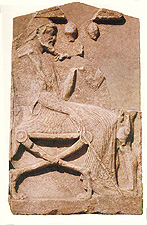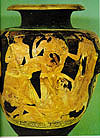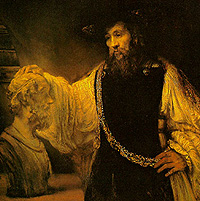Fragment of a grave stele, Ionian, 5th century BCE: East Greek
Tombstone of a Doctor
This tombstone is identifable as belonging to a doctor by the two
small cupping vessels which appear at the top of the stele. Because the
marker is damaged, we cannot know whether the figure standing at right was
a patient or assistant. |
Health was isonome, “equality before the law”, among these fluids, and
illness monarche, the dominance of one of them. This conception was taken
from the observed struggle of factions in politics. Among the many
qualities that needed to be held in balance were heat and cold, moisture
and dryness, bitterness and sweetness. This doctrine was later parlayed by
Hippocrates into the Theory of the Four Humors, which provided the basis
for medical theory up until the time of the American Revolution.
The philosophers/physicians Empedocles and Anaxagoras were
contemporaries of Alcmaeon. Like other scientists of their day, they
inquired about such quasi-medical topics as the composition of matter (is
the primary element earth, fire or water?), the seat of the human soul
(some believed it to be the heart, some the liver and still others the
diaphragm), and the procreative process of humans (most held that the male
sperm was exclusively responsible for conception). Modern scientists have
grappled with these same problems with only slightly more success than did
the Greeks. We know that atoms constitute matter and that atoms are
further divided into protons, and protons into quarks; but what smaller
constituents await discovery? The fact that 2,500 years later we are still
asking some of the same questions posed by the Greeks brings to mind the
phrase nihil sub sole novi, that is, “there is nothing new under the sun”
(Eccl.i.9). For every question we may posit, the Greeks have surely asked
and answered it.
|



 as well as
physicians and the distinction between the two fields was often blurred. At its
inception in the sixth century BCE, ancient medicine was a mere branch of
natural philosophy. Even in Late Antiquity, when the philosopher/physician Galen
reigned supreme, philosophy was considered a necessary part of medical training.
Unlike philosophy and medicine, which worked in harmony, the tension between
medicine and religious belief often stifled or impeded physiological research.
Throughout antiquity, rational medicine and faith healing existed side by side,
never fully divorcing themselves from one another Roman medicine especially was
an eclectic blend of rational Hellenistic medicine, folk remedies and religious
cult practice. Like so many other aspects of antiquity, medicine was truly
interdisciplinary, influencing and in turn being influenced by art, literature,
philosophy, politics and in no small way, religion.
as well as
physicians and the distinction between the two fields was often blurred. At its
inception in the sixth century BCE, ancient medicine was a mere branch of
natural philosophy. Even in Late Antiquity, when the philosopher/physician Galen
reigned supreme, philosophy was considered a necessary part of medical training.
Unlike philosophy and medicine, which worked in harmony, the tension between
medicine and religious belief often stifled or impeded physiological research.
Throughout antiquity, rational medicine and faith healing existed side by side,
never fully divorcing themselves from one another Roman medicine especially was
an eclectic blend of rational Hellenistic medicine, folk remedies and religious
cult practice. Like so many other aspects of antiquity, medicine was truly
interdisciplinary, influencing and in turn being influenced by art, literature,
philosophy, politics and in no small way, religion.
